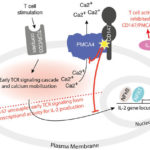Tag Archives:drug
Hot or Not – The Heat Shock Factor1 (HSF1) is essential for Candida albicans cellular functioning
Applying nanopharmacology to obstetrics: A novel targeted drug delivery system for the uterus
Gold-silver nanoparticles instead of traditional diabetic drugs
3rd International Conference and Expo on Drug Discovery & Designing. Vienna, Austria. October 02-04, 2017
Artemisia annua leaves improved solubility of antimalarial drug, artemisinin
Simple mathematical formulas for tracking the number of antibiotic resistance cases globally
Glutathione-responsive co-assembly hydrogel for controllable drug release
Are less expensive “biosimilar” drugs as effective at treating ankylosing spondylitis?
Can a doughnut-shaped molecule help design new drugs?
Clues for innovative therapies targeting the c-ring of the F1FO-ATP synthase
Increasing evidence points out that the ATP synthase/hydrolase, also known as F1FO-complex, can be the key enzymatic switch between cell life and death. So, the enzyme complex, which bears the task of building most cellular ATP, the
A new drug target for healthful aging
Special molecular mechanism makes CD147 an interesting drug target in cancer or autoimmune diseases
An international team opens new avenues toward PKU therapy
The apothecary inside us
Using computers to understand the deposition of pollutant and therapeutic aerosols in the human lungs
Continuing the age of discovery in cardiovascular disease
A rare genetic defect involving the heart muscle is leading to early heart failure and potentially lethal heart rhythms for patients in Saudi Arabia. This disease, called Arrhythmogenic Right Ventricular Cardiomyopathy/Dysplasia or ARVC/D, involves healthy heart muscle
Prompt resolution of essential drug intolerance
Drugs and drowning
Electrical activity of the heart is commonly monitored by the electrocardiogram (ECG). Such electrical activity depends on certain proteins called ion channels. These channels control the timing and the flow of electrically charged particles (ions) in and
Improving nature’s own communication system to fight cancer
A promising novel drug for breast cancer
The reason cancer is so difficult to treat is that cancer cells are our own cells running wild, which means that they generally do not make any protein or other molecule that normal cells don’t make. This





















